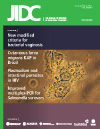Risk factors for Shiga toxin-producing Escherichia coli infections in preadolescent schoolchildren in Buenos Aires, Argentina
DOI:
https://doi.org/10.3855/jidc.1894Keywords:
Shiga toxin–producing Escherichia coli, risk factors, foodborne diseaseAbstract
Introduction: Shiga toxin-producing Escherichia coli (STEC) infections are the leading cause of hemolytic uremic syndrome (HUS). STEC is the most common cause of acute kidney disease, responsible for 20% of renal transplants in Argentina.
Methodology: In 2007, an epidemiological survey was conducted among 883 students from the fifth and sixth years of elementary education in the public schools of San Martin City, Buenos Aires, Argentina. Degree of exposure to the known risk factors previously detected in the region as primary causes of STEC infections was evaluated. Risk factors assessed included consumption of hamburgers, poor personal hygiene, and exposure to various types of drinking and recreational water. The study was designed to evaluate exposure to risk factors for STEC infections among different socioeconomic groups.
Results: Ninety-five percent of children surveyed reported consumption of hamburgers. Most of these hamburgers were precooked. Children of high and medium strata attended private swimming-pools, while children from the low stratum attended public pools. Only 30.2% of students washed their hands after going to the toilet and only 43.5% reported hand-washing before eating.
Conclusions: Students demonstrated high levels of exposure to identified risk factors for STEC infections. Reduction of these risks will require cultural changes aimed at decreasing morbidity caused by food-borne infections. Institutional framework must provide the necessary resources to implement these changes and emphasize the importance of good personal hygiene. Health education must be implemented to increase food safety awareness of the consumers.
Downloads
Published
How to Cite
Issue
Section
License
Authors who publish with this journal agree to the following terms:
- Authors retain copyright and grant the journal right of first publication with the work simultaneously licensed under a Creative Commons Attribution License that allows others to share the work with an acknowledgement of the work's authorship and initial publication in this journal.
- Authors are able to enter into separate, additional contractual arrangements for the non-exclusive distribution of the journal's published version of the work (e.g., post it to an institutional repository or publish it in a book), with an acknowledgement of its initial publication in this journal.
- Authors are permitted and encouraged to post their work online (e.g., in institutional repositories or on their website) prior to and during the submission process, as it can lead to productive exchanges, as well as earlier and greater citation of published work (See The Effect of Open Access).








